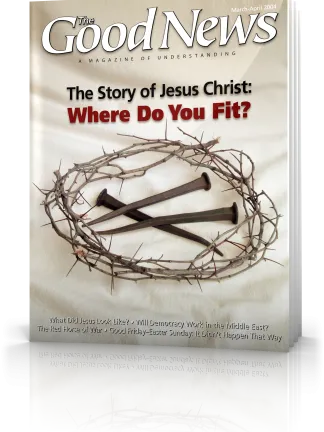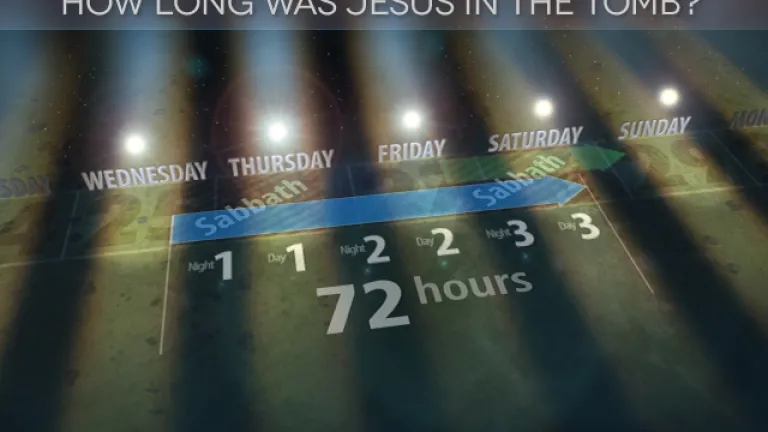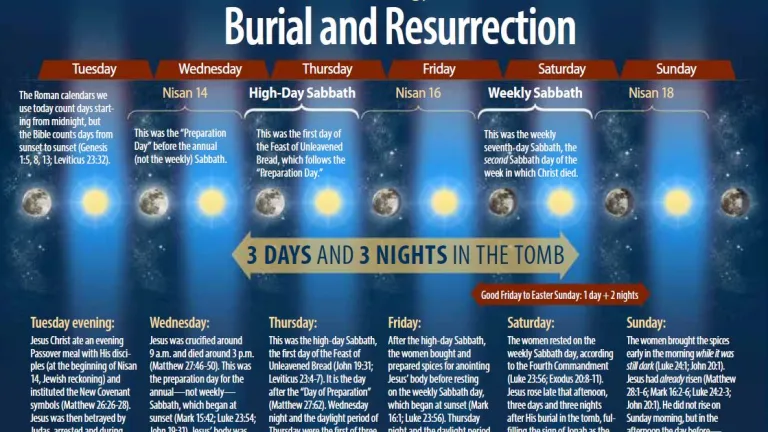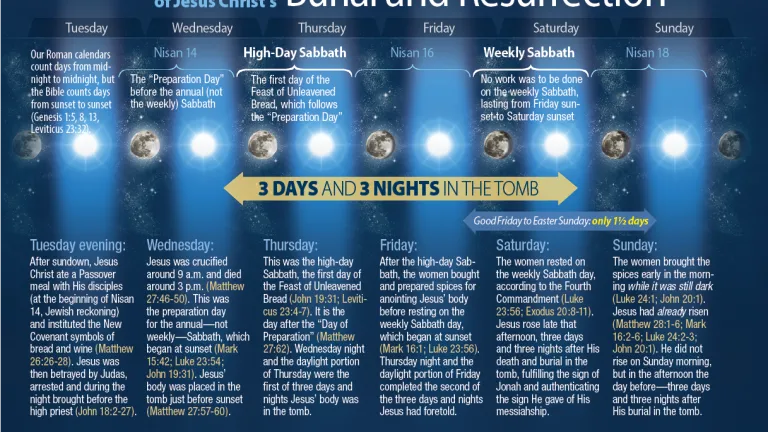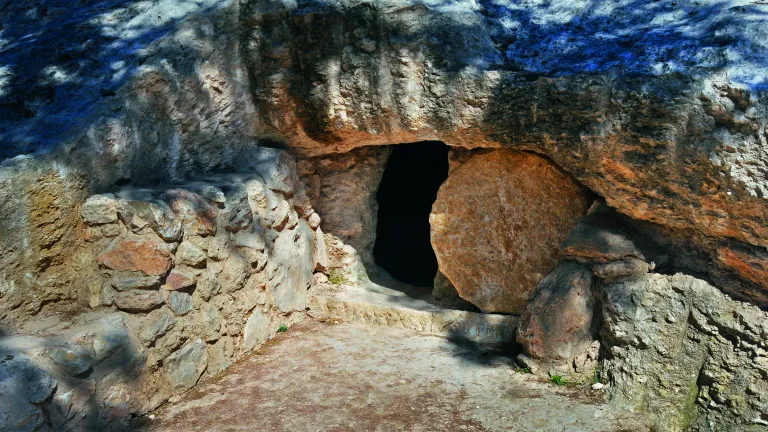Good Friday - Easter Sunday: It Didn't Happen That Way!
Do you remember when you learned that Santa Claus wasn't real? Guess what? Good Friday and a Sunday resurrection aren't either. Discover the real story from the pages of the Bible itself!
At the beginning of the first century, hope for a Messiah burned in the hearts of many Jews. Prophecies in Deuteronomy, the Psalms and the writings of the Prophets all had proclaimed the coming of this promised Deliverer.
Divergent views about what the Messiah would be and do were common. Some thought he would be a great prophet, others another Elijah. Many expected Him to be a warrior king like David who would overthrow their Roman overlords and reestablish the glory of Israel. Basing their belief on prophecies from the book of Daniel, many were convinced the time was near.
It was during this time of great expectation that larger and larger crowds began gathering to hear a young preacher cry out to his countrymen to repent and return to God. His message was so powerful that it prompted some to wonder if he were the One to come. They asked, "Who are you?" He answered that he was not the Christ ("Christ" is the Greek translation of the Hebrew word Messiah), but was sent to prepare the way for Him (John 1:19-23).
The brief ministry of John the Baptist pointed to one who was born of humble origins, one called Jesus. Jesus' ministry was supported by signs and wonders. His divinity was accepted by some and rejected by others. Some came only to eat (John 6:26-27), others to be entertained by the healings and other miracles. None had seen such miracles nor heard one speak as this teacher from Nazareth.
Sign of the true Messiah
Speculation as to the real identity of Jesus was a popular topic of conversation. But most of the religious leaders viewed Him as a threat to their position. One day a group of them tossed a challenge out to Him: "Teacher, we want to see a sign from You" (Matthew 12:38).
Were they asking for proof of His divinity, or were they just asking for more miracles to titillate their senses? The godly are more impressed by truth than by signs.
"But He answered and said to them, 'An evil and adulterous generation seeks after a sign, and no sign will be given to it except the sign of the prophet Jonah. For as Jonah was three days and three nights in the belly of the great fish, so will the Son of Man be three days and three nights in the heart of the earth'" (Matthew 12:39-40).
How many who profess to follow Christ today have really thought about what these two verses say? Have you? Why was this one sign so important?
The One we worship as the Christ, the Savior, and Son of God said that the only outward visible sign of His genuineness as the Messiah was that as Jonah was three days and three nights inside the fish, He would be entombed for three days and three nights in the earth.
It was Jesus' way of saying that he would die, yet remain dead for only a short time—and these two facts together would prove that He is the true Messiah. And, as a part of the only sign that He gave to prove His identity as the Christ, He precisely specified the length of time He would remain dead.
Three days and three nights comprise a total of 72 hours. Yet today it is almost universally believed that Jesus died and was buried on late Friday afternoon and was resurrected early Sunday morning. If that belief is really true, then, based on His own words, the only sign of His Messiahship has utterly failed—for there are not three days and three nights between Friday afternoon and Sunday morning, but only one day and two nights!
Prophecies of time in the tomb
Over and over, Christ had told His disciples of His upcoming burial and resurrection. "From that time Jesus began to show to His disciples that He must go to Jerusalem, and suffer many things from the elders and chief priests and scribes, and be killed, and be raised the third day" (Matthew 16:21, emphasis added throughout).
"... Jesus said to them, 'The Son of Man is about to be betrayed into the hands of men, and they will kill Him, and the third day He will be raised up'" (Matthew 17:22-23).
"And He began to teach them that the Son of Man must suffer many things, and be rejected by the elders and chief priests and scribes, and be killed, and after three days rise again" (Mark 8:31).
Mark records Christ stating here that His resurrection would occur after or at the end of three days—not after one day, or one and a half days, or two days, but after three days. So Jesus must have been resurrected just as the third day was ending, three days and three nights after He was placed in the tomb.
This is the only way Jesus' statements can be consistent. And consistent they are. When some of His followers came to the tomb looking for Him early Sunday morning, the angels told them He wasn't there; He was already risen as He said (Matthew 28:6; Luke 24:5-7).
Interestingly, when Peter was teaching the first gentiles called into the Church, he taught them that Jesus was the Christ (the Messiah), that He was put to death and was raised out of the grave "the third day."
"That word you know, which was proclaimed throughout all Judea ...: how God anointed Jesus of Nazareth with the Holy Spirit and with power, who went about doing good and healing all who were oppressed by the devil, for God was with Him. And we are witnesses of all things which He did both in the land of the Jews and in Jerusalem, whom they killed by hanging on a tree. Him God raised up on the third day, and showed Him openly" (Acts 10:37-40).
Why was it necessary that Peter add "the third day"? Peter was confirming that Christ indeed had fulfilled the sign of Jonah! Years later, the apostle Paul affirmed not only the resurrection of Jesus Christ, but also that it was on the third day:
"For I delivered to you first of all that which I also received: that Christ died for our sins according to the Scriptures, and that He was buried, and that He rose again the third day according to the Scriptures, and that He was seen by Cephas [Peter], then by the twelve [apostles]" (1 Corinthians 15:3-5).
Does "three days" or "the third day" mean parts of three days—Friday night, all day Saturday and Saturday night, and Sunday morning?
The Companion Bible answers: "The fact that 'three days' is used by Hebrew idiom for any part of three days and three nights is not disputed; because that was the common way of reckoning, just as it was when used of years ... But, when the number of 'nights' is stated as well as the number of 'days', then the expression ceases to be an idiom, and becomes a literal statement of fact" (1990, appendix 144).
Since it is impossible to fit three days and three nights between late Friday afternoon and Sunday morning, we have a serious timing problem. The traditional view of a "Good Friday" burial and an "Easter Sunday" resurrection cannot be reconciled with Jesus Christ's own statements about how long He would be in the tomb. They cannot both be right.
"The preparation day"
Why do most churches assume and teach that Christ died and was buried on Good Friday? Tradition, for one thing! That's what most people have always been taught.
Also, they assume this is what the Bible teaches. The Scriptures do say that He was buried on "the preparation day," the day before a Sabbath.
Heavy cooking and housecleaning were done on the day before a Sabbath in preparation for it. And the weekly Sabbath falls on Saturday, the seventh day of the week.
Also, according to Bible reckoning days begin at sunset (Leviticus 23:32; compare Genesis 1:5, 8, 13), so all weekly Sabbaths start Friday evening at sunset.
Mark 15:42-46 does tell us plainly that Jesus was entombed late in the afternoon on the "preparation day," just before the Sabbath began at sunset: "Now when evening had come, because it was the Preparation Day, that is, the day before the Sabbath, Joseph of Arimathea, a prominent council member, who was himself waiting for the kingdom of God, coming and taking courage, went in to Pilate and asked for the body of Jesus.
"Pilate marveled that He was already dead; and summoning the centurion, he asked him if He had been dead for some time. So when he found out from the centurion, he granted the body to Joseph. Then he [Joseph] bought fine linen, took Him down, and wrapped Him in the linen. And he laid Him in a tomb which had been hewn out of the rock, and rolled a stone against the door of the tomb."
Two kinds of Sabbaths—weekly and "high day"
What few people realize is that the Sabbath spoken of here was not the weekly Sabbath day, which begins on Friday at sunset and lasts until Saturday sunset.
The apostle John specifically tells us that the day on which Jesus was crucified immediately preceded a special Sabbath, not the regular weekly Sabbath. "Therefore, because it was the Preparation Day, that the bodies should not remain on the cross on the Sabbath (for that Sabbath was a high day), the Jews asked Pilate that their legs might be broken, and that they might be taken away" (John 19:31).
That Sabbath, we see from Scripture, was "a high day." In addition to the weekly Sabbaths, God also commanded seven Holy Days or annual Sabbaths (see Leviticus 23), most of which could fall on different days of the week. A number of commentaries and Bible helps will tell you that John is here referring to one of these annual Sabbaths rather than the weekly Sabbath.
Jesus Christ, like the Passover lamb that was killed to spare the ancient Israelites from the death angel, was slain on Passover day (read John 19). The Passover is observed on the 14th day of the first month of the Hebrew calendar. The next day begins the Feast of Unleavened Bread. The first day of Unleavened Bread, the 15th of Abib, is an annual Sabbath.
"On the fourteenth day of the first month at twilight is the LORD's Passover. And on the fifteenth day of the same month is the Feast of Unleavened Bread to the LORD; seven days you must eat unleavened bread. On the first day you shall have a holy convocation; you shall do no customary work on it" (Leviticus 23:5-7).
The Jews were rushing to finish the burials of the condemned men before the annual Sabbath began at sunset. This preparation day was the day before the first day of Unleavened Bread, a high day or annual Sabbath. The "Preparation Day" referred to in Mark 15:42 and John 19:31 was the day before the Holy Day that began the Feast of Unleavened Bread.
Paraskeue, the Greek word translated "Preparation Day," is "used in reference to the day or hours spent in preparation for the Jewish Sabbath or festivals ..." (Spiros Zodhiates, The Complete Word Study Dictionary: New Testament, 1993, p. 1113).
Proof of two Sabbaths in the Gospels
There were actually two Sabbaths that week—an annual Sabbath "high day" and a regular weekly Sabbath day. This is proven by the Gospels' statements regarding Mary Magdalene and the other women, who planned to put more spices and ointments on Christ's body, having been unable to do so because He had been so hurriedly entombed.
In Mark 16:1, we read that they purchased the necessary spices "when the Sabbath was past"—clearly after it was over. But then in Luke 23, we are told that they prepared the spices and fragrant oils and then rested on the Sabbath, which means they had to have acquired the spices before that Sabbath on which they rested.
"That day was the Preparation [Day], and the Sabbath drew near. And the women who had come with Him from Galilee followed after, and they observed the tomb and how His body was laid. Then they returned and prepared spices and fragrant oils. And they rested on the Sabbath according to the commandment" (Luke 23:54-56).
Since it was unlawful to buy, sell or work on the Sabbath, the women had to wait until the annual Sabbath was past before they could purchase the spices.
They did this on Thursday evening or early Friday. There was not enough time to both buy and prepare the spices plus put them on Christ's body.
So they rested on the weekly Sabbath after purchasing and preparing them, intending to put them on His body early Sunday morning.
When we compare the different Gospel accounts, the true sequence of events becomes clear. The women purchased and prepared the spices when the first Sabbath (the annual high day) was past, then rested on the following day, which was another Sabbath—the regular weekly Sabbath day. (To see these events spelled out day by day, see the chart above.)
The true chronology of events
In the year A.D. 31, the year Jesus was crucified, the Passover fell on a Wednesday, April 25, with the first day of Unleavened Bread following on the next day, Thursday. He died shortly after 3:00 p.m. on Passover day, Wednesday afternoon.
"Now it was about the sixth hour [of daylight, corresponding to 12 noon], and there was darkness over all the earth until the ninth hour. Then the sun was darkened, and the veil of the temple was torn in two. And when Jesus had cried out with a loud voice, He said, 'Father, into Your hands I commit My spirit.' Having said this, He breathed His last" (Luke 23:44-46).
Between the ninth hour (3 p.m.) and sunset on Wednesday, Joseph of Arimathea and Nicodemus asked for permission to remove His body to wrap and put it in a tomb which was close by.
"After this, Joseph of Arimathea, being a disciple of Jesus, but secretly, for fear of the Jews, asked Pilate that he might take away the body of Jesus; and Pilate gave him permission. So he came and took the body of Jesus. And Nicodemus, who at first came to Jesus by night, also came, bringing a mixture of myrrh and aloes, about a hundred pounds.
"Then they took the body of Jesus, and bound it in strips of linen with the spices, as the custom of the Jews is to bury. Now in the place where He was crucified there was a garden, and in the garden a new tomb in which no one had yet been laid. So there they laid Jesus, because of the Jews' Preparation Day, for the tomb was nearby" (John 19:38-42; compare Luke 23:50-55).
That Wednesday evening began the "high day," or annual Sabbath beginning the Festival of Unleavened Bread. This annual Sabbath ended Thursday evening at sunset.
The next day, Friday, the two Marys went out and purchased more spices to add to the body of Christ and spent the rest of the day preparing them. "Now when the Sabbath was past, Mary Magdalene, Mary the mother of James, and Salome bought spices, that they might come and anoint Him" (Mark 16:1).
They then rested on Saturday, the weekly Sabbath, before getting up early Sunday morning to go to the tomb to put the spices on His body. "And the women who had come with Him from Galilee followed after, and they observed the tomb and how His body was laid. Then they returned and prepared spices and fragrant oils. And they rested on the Sabbath according to the commandment.
"Now on the first day of the week, very early in the morning, they, and certain other women with them, came to the tomb bringing the spices which they had prepared. But they found the stone rolled away from the tomb. Then they went in and did not find the body of the Lord Jesus" (Luke 23:55-24:3).
When Mary went to the tomb on Sunday morning, "while it was still dark" (John 20:1), Christ's body was not there. He wasn't resurrected at sunrise on Sunday morning. Before sunrise His body was already gone!
The truth of the matter
Jesus Christ said He would be "three days and three nights in the heart of the earth" (Matthew 12:40). If He were buried in the late afternoon, then He must have been resurrected at around the same time three days and nights later.
He was placed in the tomb by Joseph of Arimathea in the late afternoon just before the sun went down. Three days and three nights later would have been at approximately the same time of day, just as the sun went down and evening came.
This places Christ's resurrection on Saturday around sunset—not on Sunday morning! As we have already seen, when Mary went to the tomb "while it was still dark" on Sunday morning, He was already risen!
Christ was buried on Wednesday afternoon, very late, and raised from His grave around sunset three days and nights later. This perfectly fits with the three nights—Wednesday night, Thursday night and Friday night—and the three days—Thursday, Friday and Saturday. This is the only time that fits Jesus' own prediction of how long He would be in the tomb. And, as we have seen, it fits perfectly with all the details recorded in the Gospels.
The sign was fulfilled, just as He said!
The tradition of a "Good Friday" crucifixion and an "Easter Sunday" resurrection are proven from the Bible to be only a tradition—and one without basis in fact.
So which will you believe—a man-made myth, or the only sign that Jesus announced would be proof that He was who He said He was? GN
